Ulf Hundeiker reviewed Timeline by Michael Crichton
Schmarrn mit männlichen Männern und Quark mit Quanten
2 stars
Hier können Männer noch Männer und Helden sein und sich von Frauen anschmachten lassen. Die Frauen sind zwar auch irgendwie tapfer, aber die Kerle erst! Na gut, das kennt man. Die Geschichte wäre allerdings ein bissken weniger blödsinnig gewesen, wäre der Autor nicht so sehr damit beschäftigt, die angebliche Funktionsweise der Zeitmaschinen zu erklären. Natürlich aufgeblähter Blödsinn mit Quanten und Paralleluniversen, der schlicht zu ausführlich ist und zudem sehr an den Haaren herbeigezogen.
Immerhin, ein wenig unterhaltsam war es trotzdem..
Hier können Männer noch Männer und Helden sein und sich von Frauen anschmachten lassen. Die Frauen sind zwar auch irgendwie tapfer, aber die Kerle erst! Na gut, das kennt man. Die Geschichte wäre allerdings ein bissken weniger blödsinnig gewesen, wäre der Autor nicht so sehr damit beschäftigt, die angebliche Funktionsweise der Zeitmaschinen zu erklären. Natürlich aufgeblähter Blödsinn mit Quanten und Paralleluniversen, der schlicht zu ausführlich ist und zudem sehr an den Haaren herbeigezogen.
Immerhin, ein wenig unterhaltsam war es trotzdem..






